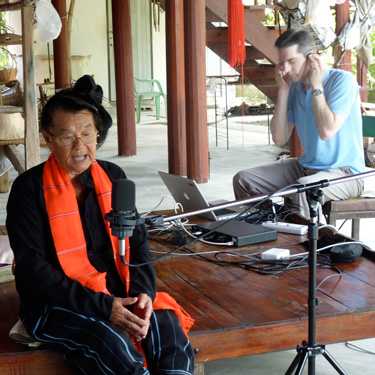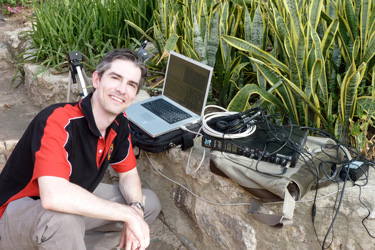|
 John Latartara takes the Metric Halo ULN-2 to remote corners of the world – recently to Southeast Asia to record the vanishing music of the Tai Dam people. Performing is Noi Phetrod, a 76 year-old woman from Koratt village, Nakhonpathom province Thailand. © 2011 Photos by Wan Petchroon John Latartara takes the Metric Halo ULN-2 to remote corners of the world – recently to Southeast Asia to record the vanishing music of the Tai Dam people. Performing is Noi Phetrod, a 76 year-old woman from Koratt village, Nakhonpathom province Thailand. © 2011 Photos by Wan Petchroon
SOUTHEAST ASIA: John Latartara received his doctoral degree in Theoretical Studies from the prestigious New England Conservatory of Music in Boston, Massachusetts and is currently an associate professor of music at the University of Mississippi. With interests and aptitudes neatly divided among the three complementary activities of composition, research, and teaching, Latartara makes extensive personal and professional use of his Metric Halo ULN-2 FireWire interface. The ULN-2, which combines peerless mic preamps, converters, and recording software integration, forms the heart of his home studio, where he creates electronic and experimental music (releases on Sachimay, Centaur, and Visceralmedia Records). But the ULN-2 also travels with Latartara to points far and remote in support of his research. Most recently, Latartara has been traveling throughout Southeast Asia to document the rare, and slowly vanishing, music of the Tai Dam people.
“Lack of fidelity in what are typically classified as ‘world music’ recordings is something that always bothers me,” said Latartara. “When I was younger, I remember buying recordings of music from different parts of the world in which the music itself was fascinating, but the audio quality was completely lacking. The recordings were thin-sounding and lacked detail. Sometimes there was obvious clipping, as if audio quality was somehow unimportant.” For his own research and documentation, Latartara was determined to avoid that same failing. After much research and many comparisons, he determined that the Metric Halo ULN-2 would provide him with the utmost fidelity in a remarkably portable and robust build.
The Tai Dam people are an ethnic group with populations in Laos, Vietnam, Southern China, Thailand, and the United States. Despite their distance, the sub-populations of Tai Dam people share a common language, a common culture, and a common music. Latartara first heard the music of the Tai Dam people three years ago and was so captivated by its beauty that he had to learn more. As an academic, he was excited to learn that very few had ever researched the music of the Tai Dam people. But as he learned more, he was also saddened. “Aspects of this musical culture are in danger of dying out,” Latartara revealed. “For instance, one singer in Thailand I recently recorded and interviewed who specializes in Tai Dam wedding ceremonies said he has no students. When he dies so does the tradition of the ceremony. This inspired me to record as much as I could before it is lost forever.”
Latartara is currently splitting his time between duties at the University of Mississippi and fieldwork in Southeast Asia. He typically brings his recording equipment – which consists of an AKG C414 XLS microphone, the Metric Halo ULN-2, and a MacBook Pro – to a musician’s house, where he lets the musician choose what he or she wishes to perform. He uses the Metric Halo MIO console on his MacBook Pro so that he can set up in moments, ready to capture anything. “I just set up my mic, ULN-2, and computer, open MIO Console, and press record. That’s it,” he said.
 John Latartara with his ULN-2 John Latartara with his ULN-2
Apart from stunning fidelity, Latartara cited reliability and convenience as critical components of what makes the Metric Halo ULN-2 so valuable. “I conduct most of my recordings in small, remote villages, often hours from even a basic convenience store,” he said. “If something breaks or crashes I lose the recording – I get no second chances. The ULN-2 is extremely reliable and stable. I’ve never had any problems with the unit, and I’ve never had any crashes while recording – not even a minor glitch. I think that’s especially impressive considering I’m recording, for hours on end, in some extreme environments: 100-plus temperatures with 99% humidity and a regular rotation of insects (and sometimes even monkeys) that keep trying to make a home or a game of the unit. I remember one recording session that was so hot and humid, I had to keep wiping the sweat off my hands because I was getting electric shocks whenever I touched my computer! That was a challenging recording session, but the ULN-2 was rock-solid all the way through.”
Latartara is currently working on a book about the music and culture of the Tai Dam people. With it, he will include a CD and/or DVD that contains the recordings he made with the Metric Halo ULN-2. |